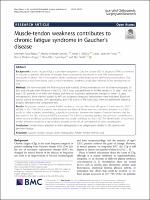Please use this identifier to cite or link to this item:
https://repositorio.usj.es/handle/123456789/293
| Title: | Muscle-tendon weakness contributes to chronic fatigue syndrome in Gaucher's disease. |
| Authors: | Roca-Espiaú, Mercedes

Andrade-Campos, Marcio 

Cebolla, Jorge Javier 


López de Frutos, Laura 

Medrano-Engay, Blanca 

López-Royo, María Pilar 

Giraldo, Pilar 


|
| Keywords: | Achilles tendon stiffness; Fatigue; Gaucher disease; QoL; Strain-elastography |
| Issue Date: | 21-Nov-2019 |
| Publisher: | BMC |
| Citation: | Roca-Espiau, M., Andrade-Campos, M., Cebolla, J.J. et al. Muscle-tendon weakness contributes to chronic fatigue syndrome in Gaucher’s disease. J Orthop Surg Res 14, 383 (2019) doi:10.1186/s13018-019-1452-y |
| Abstract: | BACKGROUND: Chronic fatigue (CFg) is a prevalent symptom in Gaucher disease (GD) at diagnosis (79%) and remains in a quarter of patients after years of therapy. Bone abnormalities are present in over 70% and peripheral neuropathy in about 11% of the patients, which contributes to the disabling and debilitating complications. Our hypothesis is that other factors such as muscle-tendinous weakness could have influence in the development of CFg. METHODS: We have evaluated the fiber structure and elasticity of muscle-tendinous unit by strain-elastography (S-ELA) and analyzed their influence in the CFg. S-ELA study was performed in Achilles tendon in 25 type 1 and two type 3 GD patients, all of them with fatigue and were on enzymatic replacement therapy for mean 13years; simultaneously, bone marrow burden by MRI and calcaneus ultrasound densitometry were evaluated. Blood cell counts, plasma biomarkers, GBA1 genotyping, and SF36 quality of life scale (QoL) were also performed. STATISTICAL ANALYSIS: descriptive and comparative test. RESULTS: All patients showed a normal Achilles tendinous structure. Abnormal stiff grade 2-3 was found in 17/27 (62.9%); in 11/27 (40.7%) of patients, the alteration was bilateral. There were no correlations between the S-ELA results to other variables; nevertheless, a significant correlation between the degree of tendon hardness and the low score on the QoL scales (p=0.0035) was found. The S-ELA is a sensitive painless, fast, and low cost method to detect muscle-tendinous subclinical dysfunction that could contribute to CFg in GD. The identification of subclinical tendon alteration would be a sign of alarm, focused on the risk of development of bone complications. CONCLUSION: Intratendinous alteration in strain-elastography is an independent variable in GD patients with persistent fatigue. |
| URI: | https://repositorio.usj.es/handle/123456789/293 |
| ISSN: | 1749-799X |
| Appears in Collections: | Artículos de revistas |
Files in This Item:
| File | Description | Size | Format | |
|---|---|---|---|---|
| s13018-019-1452-y.pdf | 2,21 MB | Adobe PDF |  View/Open |
This item is licensed under a Creative Commons License

